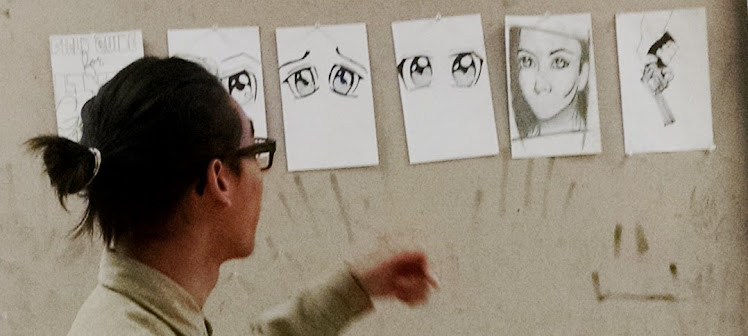Art 1010 Two Dimensional Design
Spring 2011
T,TH- 2:20pm-5:20pm Rm 413 Trahern
Professor: Mike Mitchell(aka mikewindy)
Office: Trahern 207
Phone: 221-7333
Office hours: Tuesday-Thursday 10am-11am
Catalog Description
Fundamental experience in two-dimensional design, with emphasis on the elements and principles of design and creative development, and media-skills training.
Course Objectives
This is an introductory level course in two-dimensional design. It is intended to give a basic and broad understanding of composition on a flat plane using the elements and principles of design. The course will focus on technical skills and creative processes equally: you will acquire a vocabulary of abilities and design strategies on which to build for the rest of your career. To succeed in this class you must exercise visual and conceptual problem solving skills; I hope that you will learn to take the assignments apart and put them together in new ways. You will also learn art terminology that will make talking about and looking at art easier, which is something we will do together a great deal.
Grading
Grades will be based on a point system according to the following:
250 Exercises (5 at 50 each)
500 Projects (5 at 100 each)
100 Final Exam (Vocab and skills test)
150 Attendance, participation in discussions class activities and critiques (4 points per day)
__________________________
1000 Points possible
900-1000 = A
800-899 = B
700-799 = C
600-699 = D
Below 600 = F
All work must have a cover sheet attached and be ready for critique at the beginning of class on the due date. If it is not ready at the beginning of class, it will be counted late. Late work will receive a 10 point deduction for each class period it is late. Work that is late due to a documented excused absence will not be penalized.
A mid-term grade shall be awarded for all students in this course. The grade awarded may not necessarily be based on 50% of the course requirements and may or may not differ from the final grade. Your mid-term grade will be posted on AP Web.
*All work that is originally submitted on time may be reworked and resubmitted at any time throughout the semester, for a possible grade change.
Attendance
Attendance will be taken sometime near the beginning of each class period. You must be here when I call your name. I need to watch you work to be able to help you. And you need to watch each other work to save yourself some trouble. If you come to the studio after attendance is called it is your responsibility to make sure that I change you from absent to tardy in my attendance book. Insist on watching me do it.
You will receive daily attendance/participation points. Failure to attend class will result in a lowered attendance grade that may adversely affect your final grade. You will not be penalized for excused absences. An excused absence is one that cannot be avoided, and with documentation (medical reasons, jury duty, etc.) I will not excuse absences for alarm clock malfunctions, misplaced car keys, or other preventable circumstances. Talk to me if you are unsure if an absence will be excused or not. If you come to class late or leave early, you will receive half attendance points for that day.
We will take breaks during class. With the exception of emergencies, you are not allowed to leave the classroom without my permission. I must know where you are at all times to be accountable for you.
Misconduct
The University’s policies on academic and classroom misconduct will be strictly enforced. Academic and classroom misconduct will not be tolerated. Please refer to your copy of the student handbook for all matters pertaining to misconduct. Persistent disruption of the learning environment will result in my asking you to drop the course or automatic failure.
Disability Policy
Any student who has a disability that my affect his/her academic performance is encouraged to make an appointment with me to discuss this matter or you may contact Disability Services at 221-6230 or 221-6278 tty or 221-7102 fax.
Minors in the Classroom
Minors (any non-student under the age of 18) accompanying staff, faculty, students, or visitors on campus are not permitted in the classroom.
Class Etiquette
Be respectful. Put your cell phone on vibrate or turn it off before class. If you have an emergency, please exit the classroom quietly. Respect the professor, respect the other students, and you will receive respect. If you are addicted to texting and checking emails, do it during breaks, not during class. IPODs may be used during work time with these restrictions: one ear must remain unplugged so you can hear announcements, and the volume must be so low that your neighbor cannot hear it.
Shout Out
Thanks to Rachel Hall-Kirk for this syllabus. Kell sent it to me and it’s pretty rad!
*The above policies and procedures are subject to change, at the Professor’s discretion, in the event of extenuating circumstances.
______________________________________________________________________________
Materials:
Materials are available at the APSU Campus bookstore, at Hobby Lobby on Wilma Rudolph Blvd., across from the mall, as well as Plaza Art Supply in Nashville.
- mechanical pencil (the regular kind used for writing)
-18" metal cork backed ruler
-#11 x-acto knife and extra blades
-sketch book-get old book from thrift store to paste pages in, collage or whitewash pages
-nylon paintbrush set (Loew-Cornell is a good brand, and cheap)
-acrylic paint:
Red - napthol or alizarin crimson or cadmium red
Blue - cobalt or cerulean
Yellow - cadmium light or medium
Titanium white
Mars black
-portfolio (to keep projects safe. This can be as simple as two pieces of cardboard
taped together)
-19"x 24" tracing paper
-white masking tape
-Pink Pearl eraser
-Ultra Fine Point black Sharpie
-regular point black Sharpie
-illustration board, as needed
-surface for mixing paint (white plastic plate)
-container for water (plastic cup or jar with lid(pickles)
-rubber cement
-glue stick
-optional: T-square, compass, triangle, drawing board



